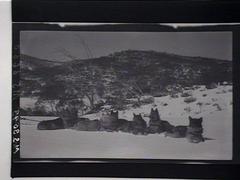
Visiting Dead Horse Gap Walking Track in Perisher Valley: A Complete Guide
Publication Date: 18/07/2024
Introduction to Dead Horse Gap Walking Track
Nestled in the heart of the Snowy Mountains in New South Wales, Dead Horse Gap Walking Track is a captivating destination for nature enthusiasts and history buffs alike. This alpine walk, situated near Perisher Valley, offers breathtaking views of the surrounding rugged landscapes, iconic peaks, and diverse alpine flora and fauna. The area holds deep cultural significance for the Ngarigo people, the traditional custodians of the land, who have traversed these alpine regions for millennia. European exploration in the early 19th century brought significant changes, with the name ‘Dead Horse Gap’ originating from a tragic incident involving a packhorse. The region’s history further evolved with the mid-20th century Snowy Mountains Scheme, an ambitious hydroelectricity and irrigation project that transformed the Australian Alps (Snowy Hydro). Today, Dead Horse Gap is a popular spot for hiking and offers a unique glimpse into the layered history and natural beauty of the Australian alpine environment.
Contents Overview
- Historical Background and Significance
- Visitor Information
- Travel Tips
- Nearby Attractions
- Accessibility
- Special Events and Guided Tours
- Photographic Spots
- FAQ
- Conclusion
- Sources and References
Historical Background and Significance
Indigenous Heritage
The Dead Horse Gap area holds deep cultural significance for the Ngarigo people, the traditional custodians of the land. For millennia, they traversed these alpine regions, utilizing the abundant natural resources for sustenance and conducting ceremonies. While specific details of their connection to Dead Horse Gap remain largely undocumented, their presence is woven into the fabric of the landscape.
European Exploration and the Origin of the Name
The arrival of European explorers in the early 19th century marked a turning point in the region’s history. The name ‘Dead Horse Gap’ is believed to have originated from a tragic incident during this period. While several versions of the story exist, the most common recounts a packhorse, laden with supplies, perishing along the challenging mountain pass. This somber event led to the area being known as Dead Horse Gap.
The Snowy Mountains Scheme and its Impact
The mid-20th century witnessed a dramatic transformation of the Australian Alps with the commencement of the Snowy Mountains Scheme (Snowy Hydro). This ambitious hydroelectricity and irrigation project, spanning over two decades, saw the construction of dams, tunnels, and power stations, forever altering the region’s landscape. While Dead Horse Gap itself was not directly involved in the scheme’s infrastructure, the influx of workers and development of nearby areas like Perisher Valley as a ski destination can be attributed to this era.
From Cattlemen to Skiers - Evolving Land Use
Prior to its emergence as a recreational hub, Dead Horse Gap played a role in the region’s pastoral history. Cattlemen, seeking lush high-country grazing pastures during the summer months, would herd their cattle through the gap. This practice, known as transhumance, has ancient roots and highlights the historical importance of such mountain passes.
The rise of skiing in the 20th century gradually shifted the focus towards tourism. The development of ski resorts like Perisher Valley, situated near Dead Horse Gap, transformed the area into a winter sports paradise. Today, the walking track provides visitors with a glimpse into this layered history, offering a unique perspective on the changing relationship between humans and the Australian alpine environment.
Visitor Information
Ticket Prices
Admission to Dead Horse Gap is free; however, parking fees may apply in nearby areas. Check local guidelines for the latest information.
Opening Hours
Dead Horse Gap is accessible year-round, though weather conditions may affect accessibility. It’s advisable to check the weather forecast and road conditions before your visit.
Travel Tips
Best Times to Visit
The best times to visit Dead Horse Gap are during the late spring and early autumn months when the weather is favorable for hiking and outdoor activities.
What to Bring
Bring appropriate clothing for variable weather conditions, sturdy hiking boots, water, and a map or GPS device. Sunscreen and insect repellent are also recommended.
Nearby Attractions
Perisher Valley
A premier ski destination, Perisher Valley offers a range of winter sports and summer hiking trails.
Thredbo Village
Thredbo Village is known for its vibrant atmosphere, offering shopping, dining, and various seasonal activities.
Accessibility
Facilities for Disabled Visitors
While some areas of Dead Horse Gap may be challenging to navigate, nearby attractions and facilities in Thredbo Village and Perisher Valley offer accommodations for disabled visitors.
Special Events and Guided Tours
Seasonal Events
Dead Horse Gap and its surrounding areas host various seasonal events, ranging from skiing competitions in winter to hiking festivals in summer.
Available Tours
Guided tours are available through local operators, providing insights into the area’s history, flora, and fauna.
Photographic Spots
Dead Horse Gap offers numerous scenic spots perfect for photography. Key locations include the walking track, viewpoints along the pass, and nearby alpine meadows.
FAQ
What are the visiting hours for Dead Horse Gap?
Dead Horse Gap is open year-round, but accessibility may be influenced by weather conditions.
Are there any guided tours available?
Yes, guided tours are available through local operators, offering historical and ecological insights.
What should I bring when visiting Dead Horse Gap?
Visitors should bring appropriate clothing for varying weather conditions, sturdy hiking boots, water, and navigation tools.
Conclusion
Dead Horse Gap is a destination steeped in history and natural beauty. Whether you’re interested in its cultural heritage, planning a hike, or looking to capture stunning photographs, this guide provides all the information you need for a memorable visit. Don’t forget to check out our mobile app Audiala for more travel tips and updates, and follow us on social media for the latest news.

